On Tuesday night Planning & Zoning held a Zoom workshop on outdoor dining open to all.
P&Z director Katie DeLuca said a potential new zoning regulation was under consideration.
She gave a history of how outdoor dining had evolved from pre-Covid, when restaurants applied to P&Z on an annual basis for seasonal permits from April to early November, to the situation today.
Prior to the pandemic, restaurants had to remove their indoor seats when in exchange for outdoor dining permits.
Then during Covid, she said, there was “a free-for-all environment.”
“I have a real problem seeing jersey barriers as a beautification tool. Driving down the Avenue right now is about as ugly as you can get.”
– John Cooper, Greenwich
“We’re now in our first year of full inside and full outside seats,” DeLuca said, adding that as a result seating had effectively doubled.
She said the question going forward was whether to continue with both full indoor and outdoor permitted.
Resident Tina Volkwein said outdoor dining should not be continued indefinitely based on the shortage of parking.
“I drive to the Avenue. I shop there. There is a terrible lack of parking opportunities for customers and clients of the businesses downtown…. We don’t really have a lot of viable off Ave, close to the Ave, parking options. It’s very fashionable to say, ‘It should be more walkable…we need bumpouts, and because cars are dangerous.’ But the reality is we are a suburb, not an urban setting.”
“People here drive and always will,” Volkwein said. “People choose to move out of Manhattan to suburban towns because they want to keep a car.”
“You cannot go to your doctors or take your children to school…without their cars,” she added. “People toting their baby carriages, their purchases…elderly people need to drive and park and do their shopping and visit their lawyer and do whatever else they need to do, with their cars.”
“Fifty-three parking spaces over the 3/4 of a mile is not all that great a loss.”
– Tom Heagney, land use attorney
“We can’t have an emergency concession we made for Covid overtake our town,” Volkwein said, adding that for a fee to the town, restaurants have use of parking spaces for outdoor dining. “That interferes with my use of the Avenue and my needs as a consumer. I don’t think that’s fair.”
Volkwein added that that with New England weather as unpredictable as it is, outdoor dining seats frequently sit unoccupied, while the parking spaces might otherwise be used.
Also, she said it was unhygienic and unsafe to eat in the street.
“I don’t understand why people want to eat in the street, next to the cars, in the fumes, with god knows what running and round. And it’s kind of ugly.”
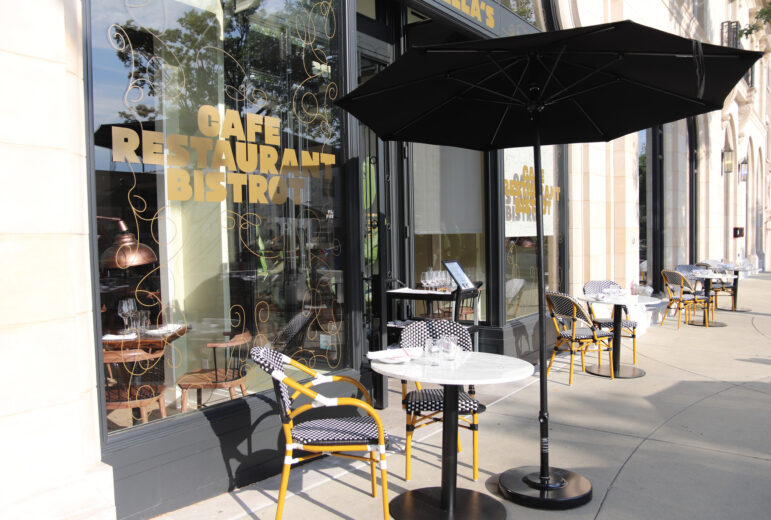
Torrey Lenzo, owner of Blankenship Dry Goods, who is on the July 14 Board of Selectmen agenda with a request to use parking spaces for his retail use, said it was unfair for the town to pick and choose who winners and losers.
“Give everyone or no one the opportunity,” he said.
Carin Ohnell, a downtown resident, said property on Greenwich Ave was likely the most valuable real estate in the state.
“These restaurateurs are getting …parking spaces for a nominal amount of money. It’s less than they pay someone to wait tables for an hour for each space. We have finite resources and we need to share them,” she said.
“We’re basically giving them free real estate,” she continued, adding that if restaurants were paying full market rate they might decide differently.
Ohnell noted that there were still pending multi-story, 8-30g affordable housing applications pending on Greenwich Avenue, in addition to an application for a large Greek restaurant on Lewis and Liberty Way, all of which will increase demand on parking if approved.
Resident John Cooper agreed with Ms Volkwein and suggested she was possibly of the majority opinion.
He said most of the parking downtown was used by non residents.
“We’re a destination,” he said. “I’m concerned that the pandemic would change life in Greenwich as we know it, for a few. I’d like to see us go back to where we were beforehand.”
“In the expansion and possible codifying (outdoor dining) going forward you have the potential of absolutely wiping out other businesses,” he added.
“The Selectmen’s office has for the past few years been selling very strongly the idea of beautifying Greenwich. That includes bump outs and little gardens. And yet, I have a real problem seeing jersey barriers as a beautification tool. Driving down the Avenue right now is about as ugly as you can get.”
Cooper referred to the idea of connecting the top of the Avenue to the waterfront as “Sherman’s march to the sea.”
“A lot of people have this on their minds and they’re frightened to death,” he added.
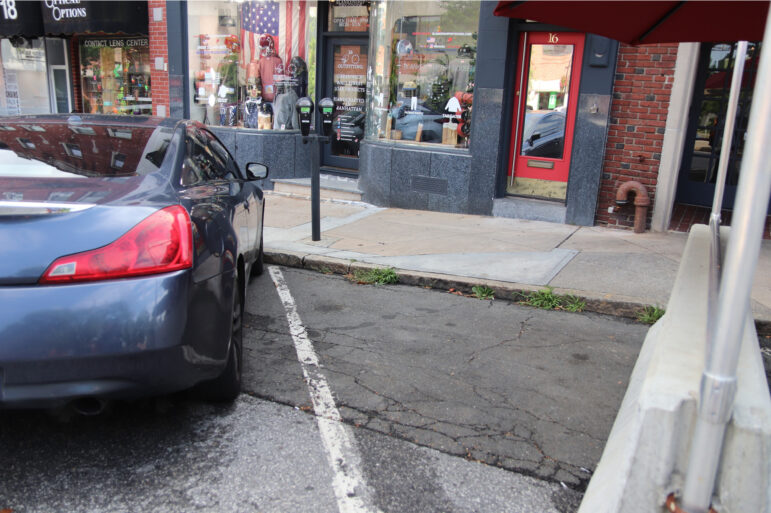
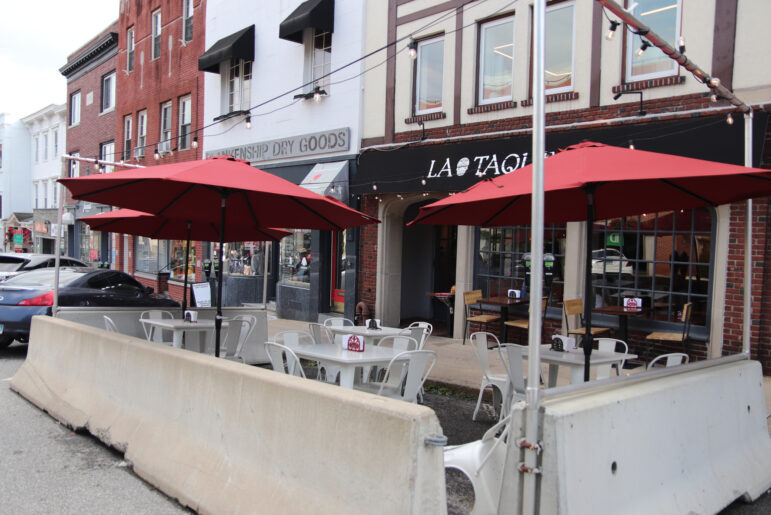
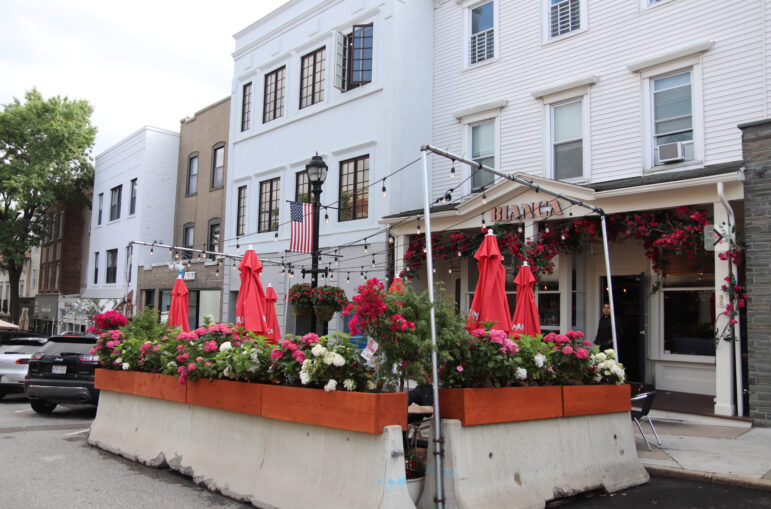
Mr. Lenzo from Blankenship Dry Goods said that restaurants with outdoor dining often obstruct the sidewalk, yet when he put a rack of merchandise on the sidewalk the police responded immediately.
He said the node for the restaurant next door to his store juts out into a parking spot in front of his store, rendering it unusable.
He said outdoor dining nodes give a limited resource to one group at the expense of others.
“You have to either give everyone the opportunity to do this, or give no one the opportunity to do this,” Lenzo said. “It has nothing to with health any more.”
Commissioner Peter Lowe seemed to agree.
“My recollection was the genesis of providing this extra space outdoors for restaurants was to sustain these restaurants during a very difficult time of Covid,” Lowe said. “It was a little bit of a bonus to help out these local restaurants. When that turned out to be very successful for the pubic to use restaurants and soften the effects of Covid, that was great. But we have entered a different time frame.”
“As I listen to this one retailer I wonder why that state of affairs we created – why should that continue?” Lowe asked.
Parking Garages and Trolley Shuttles
Mr. Lenzo talked about creating a surplus of parking and the urgency to “urbanize.”
Lenzo said he had hired an architect to create renderings of tiered parking, both underground and above ground, in municipal lots.
“Every single lot could be a multi-tiered lot,” he said.
Lenzo said Greenwich Ave could be “the new Madison Avenue.”
Ms Alban said the word urbanize was anathema to many in Greenwich, including herself.
“I want to keep my green town, my gentle suburb. That’s why I’m on P&Z,” Alban said.
Ms DeLuca said both the idea of running a trolley up and down the Avenue (again) and the idea of a multi-tier parking garage(s) had been come up repeatedly over the decades.
(How Far Would You Go for Parking in Greenwich? 1969 “Lewis-Elm Parking Deck” Idea Ditched Jan 15, 2015)
Ultimately, both she and Ms Alban said the townspeople had balked at the idea of a parking garage.
“A parking structure is a very urban thing in people’s minds,” Alban said.
That said, Alban conceded, “(A parking garage) doesn’t have to look urban. Nowadays there are beautiful parking buildings that you can’t tell are a parking structure.”
Traffic Flow on Greenwich Ave
“Someone said (in an email) that they were stuck on the Avenue, and a UPS truck had stopped to deliver in front of a node, so there was no place to pull over. And just as they stopped, two other cars on the other side of the street start pulling out. So now the Avenue is dead frozen.”
“I think that was a powerful image of what happens to the flow of the Avenue with the nodes,” Alban said.
Land use attorney Tom Heagney said, “I think outdoor dining has been a great success and provided vitality our town had been sorely lacking.”
“There is a symbiotic relationship between the restaurants and the other stores on the Avenue,” Heagney said. “If you don’t have people coming to your town for one reason or another, you’re going to stagnate. The other times when the Ave had 30-40 vacancies, I think, allowing for the liquor permits to proliferate has been a positive thing. I know the commission was very worried about that…but overall it’s been very positive.”
(P&Z Strikes Down More Distance Separation Rules for Greenwich Restaurant Liquor Licenses May 6, 2015)
“Fifth-three parking spaces over the 3/4 of a mile is not all that great a loss,” Heagney continued, adding that between 12:00 noon and 3:00pm was the “sweet spot” for parking on the Avenue when it is hardest to find a parking space.
“It’s like what schools deal with in the morning and afternoon for drop off and pick up: How much space do you devote to circulation and parking when you also want to have fields and parking? You have to balance that, and provide other uses than just parking.”
Vin DiMarco said the town had missed opportunities to build multi-tier parking structures over the years. He gave the example of when the movie theater at 356 Greenwich AVe closed and ultimately became the Apple Store.
“It could be a place where people park in a beautiful, lit, pleasant parking structure and be able to walk right onto the Avenue, and eliminate all that guesswork of driving down the Avenue trying to find a space right in front of the store,” DiMarco said.
“This can be done in phases and I’m encouraged by the number of people interested in that concept,” he said. “It just happens that the outdoor dining this is what’s in front of us.”
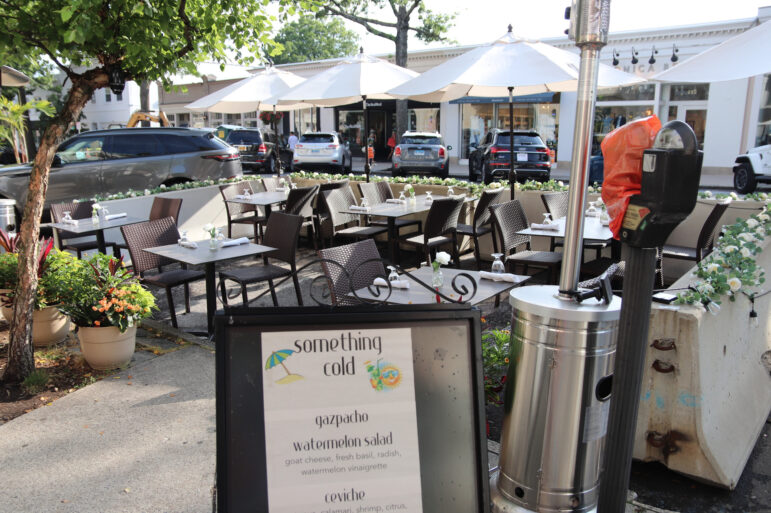
Greenwich Police Dept Deputy Chief Kraig Gray, who is in charge of Parking Services, said the town has 200 Central Greenwich Permits available, by statute, for residents and merchants/employees.
He said about 30 permits remain available.
The permits are for 12 hour municipal lots and the idea is to discourage residents/merchants/employees from feeding meters on the Avenue.
Gray said there are 408 parking spaces on the Avenue, and 46 spaces are displaced by outdoor dining nodes.
Shanice Becker from P&Z said the calculation was more like 65 spaces, if the count included “portions thereof.”
P&Z director Katie DeLuca and commission chair Margarita Alban said the BET had budgeted $75,000 for a downtown study, though no consultant has been hired yet.
Ms Ohnell said that when she was recovering from an ankle surgery and had a temporary handicapped parking permit, she became aware of where the handicapped spaces are located. She noticed that an ADA space in front of Mediterraneo had been moved around the corner to make room for a node.
“We need to think about people with limited mobility,” she said.
Evolution of Greenwich Avenue
There was talk about how the mix of establishments had evolved from mom-and-pop stores to high-end luxury stores and national chains. The Ave has become a destination for out-of-towners and the town has gone from affluent to even more affluent.
Ms DeLuca noted the town’s population nearly doubled in the late 50s/early 60’s.
“Not only did we begin to talk seriously about parking and traffic, but (in the 60s and 70s) we began to change our zoning to begin to cut back on growth,” Alban said.
Alban said the point about ADA spaces was valuable, considering Greenwich’s population is older than the average town in Connecticut.
“When you are an affluent community, you are often also somewhat older, because people have established themselves,” Alban said, adding, “When we first opened the outdoor dining in the street, we had several senior citizens who wrote us to say that they were having difficulty reaching stores.”
Deputy Chief Gray said the mix of 12-hour parking, 2-hour parking, 15-minute parking, handicap parking, commercial loading zones needed to be analyzed block by block.
He pointed out that drivers for Door-Dash and Uber Eats often use loading zones because they consider themselves commercial deliveries.
“Then the actual truck driver bringing in produce has no place to park,” he said, adding that UPS also relies on those commercial spots and have more packages to deliver than ever.
“A lot of the issues that parking enforcement officers are trying to manage – a lot of it revolve around temporary parking. Just, ‘I need to get to CVS.’ ‘I need to get to the cleaners.’ ‘I need to get to the eye place to pick up my glasses.’ I guess there’s a lot of people who don’t want to deal with the Avenue so they call Door Dash or Uber Eats to let them deal with it,” Gray said. “They’re picking up from a lot of these restaurants. The locals aren’t going out any more (to restaurants). And they’re not going to the brick-and-mortar – they’re having Amazon deal with it.”
Gray suggested that in the short term, the town should take a look at balancing the types of parking, rather than talking about parking garages.
“There is also a resident component to this,” said Deputy P&Z Director Patrick LaRow. “And also the Amazon-ification of everything….There are people picking up and delivering goods in the downtown that are probably creating more problems than serving the person receiving them in their unit or on the Avenue in storefronts.”
“What I’m hearing as a theme is that the outdoor dining concerns you in the context of where town is headed…and how much we’ve change during Covid, and what has the evolution been,” Alban said, adding that her own neighborhood had changed with properties turning over to families with young children.
She said the BET had asked about future development applications and how they’re going to impact downtown.
DeLuca said that in future, it will be important to seek qualitative input from downtown residents as well as input from employees of residents.
Stay tuned.
See also:
P&Z Refers Historic Greenwich Ave Intersection Design to Experts on Greenscape Committee July 8, 2022
HDC Feedback on Havemeyer/Arch Bumpout: Respect ‘The Soul of Greenwich’
June 23, 2022